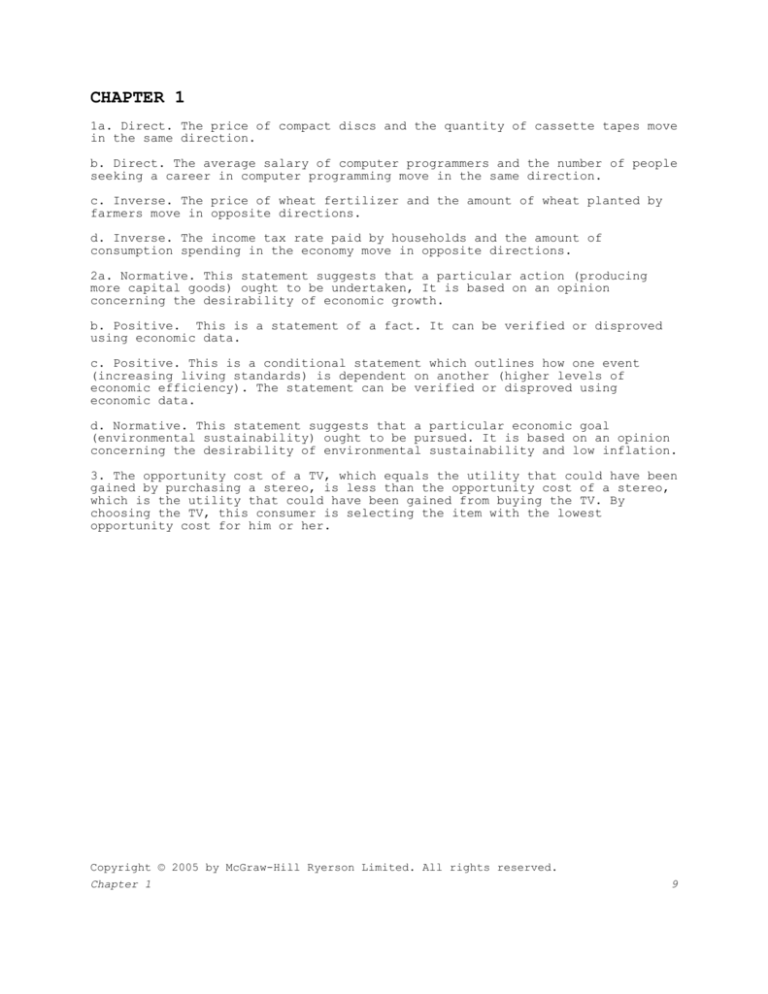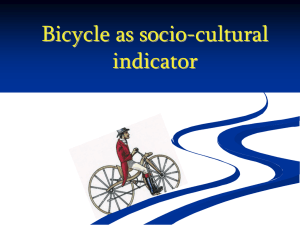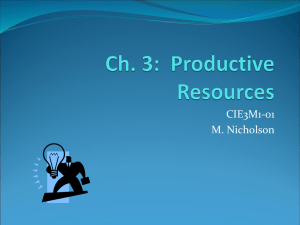
CHAPTER 1
1a. Direct. The price of compact discs and the quantity of cassette tapes move
in the same direction.
b. Direct. The average salary of computer programmers and the number of people
seeking a career in computer programming move in the same direction.
c. Inverse. The price of wheat fertilizer and the amount of wheat planted by
farmers move in opposite directions.
d. Inverse. The income tax rate paid by households and the amount of
consumption spending in the economy move in opposite directions.
2a. Normative. This statement suggests that a particular action (producing
more capital goods) ought to be undertaken, It is based on an opinion
concerning the desirability of economic growth.
b. Positive. This is a statement of a fact. It can be verified or disproved
using economic data.
c. Positive. This is a conditional statement which outlines how one event
(increasing living standards) is dependent on another (higher levels of
economic efficiency). The statement can be verified or disproved using
economic data.
d. Normative. This statement suggests that a particular economic goal
(environmental sustainability) ought to be pursued. It is based on an opinion
concerning the desirability of environmental sustainability and low inflation.
3. The opportunity cost of a TV, which equals the utility that could have been
gained by purchasing a stereo, is less than the opportunity cost of a stereo,
which is the utility that could have been gained from buying the TV. By
choosing the TV, this consumer is selecting the item with the lowest
opportunity cost for him or her.
Copyright © 2005 by McGraw-Hill Ryerson Limited. All rights reserved.
Chapter 1
9
4a.
FIGURE 1A–1 Production Possibilities Curve
The curve bows out to the right because of the law of increasing opportunity
costs. This law stems from the specialization of resources. Because the first
bicycle is produced with resources best suited to bicycle production, few
skateboards need to be given up on the vertical axis to move rightward along
the horizontal axis. But as more bicycles are produced, less suitable
resources must be devoted to bicycle production. Therefore, the sacrifice of
skateboards on the vertical axis becomes larger in relation to the increase in
bicycle production on the horizontal axis.
b. In moving from points B to C, the output of bicycles increases by 1 (= 2-1)
while skateboard production decreases by 6 (= 32-38). Therefore, a new bicycle
has an opportunity cost of 6 skateboards. In moving from points C to D,
bicycle production continues to rise by 1 (= 3-2) while skateboard output
declines by 12 (= 20-32). Therefore, a new bicycle now has an opportunity cost
of 12 skateboards. These answers illustrate the law of increasing opportunity
costs, because as more bicycles are produced there is a rise in the
opportunity cost of this product.
c. An output of 38 skateboards and 2 bicycles cannot be produced, since it
Copyright © 2005 by McGraw-Hill Ryerson Limited. All rights reserved.
Chapter 1
10
lies beyond the production possibilities curve (at point F).
d. An output of 32 skateboards and 1 bicycle is within the production
possibilities curve (at point G). It represents a situation where resources
are not being used effectively, either because they are unemployed or used at
less than their full capacity.
e. The technological improvement in the assembly of bicycles would cause the
production possibilities curve to rotate to the right, as shown by PPC1.
f. An increase in the economy’s supply of labour would cause the production
possibilities curve to shift to the right, as shown by
PPC2.
5a.
FIGURE 1A–2
b. The most stable culture is likely to be found in the country with the
largest traditional sector (Country B), since a traditional sector tends to
promote stability. The most equal distribution of income is likely to be found
in the country with the largest public sector (Country C), since one of the
main functions of government is to redistribute income. The greatest economic
freedom is likely to be found in the country with the largest private sector
Copyright © 2005 by McGraw-Hill Ryerson Limited. All rights reserved.
Chapter 1
11
(Country A), since private markets provide individuals with the liberty to
pursue their own self-interest.
c. See the two arrows in the above graph.
6. An example of a pair of complementary goals is full employment and income
equity, since a drop in unemployment decreases the income disparities
associated with joblessness. An example of a pair of conflicting goals is
income equity and price stability, since measures taken to minimize inflation
often raise the types of income (such as interest payments) received by highincome households, while reducing the job prospects and wage rates received by
low-income households.
7a. 1983: 17.7, 1984: 15.6, 1985: 14.7, 1986: 13.7, 1987: 13.2, 1988: 11.8,
1989: 12.5, 1990: 12.9, 1991: 15.9, 1992: 12.7, 1993: 13.2, 1994: 10.6, 1995:
11.6, 1996: 11.2, 1997: 10.7, 1998: 9.2, 1999: 9.3, 2000: 9.5, 2001: 9.8,
2002: 9.9.
b. The average value during the years 1983-2002 was 12.3%. The misery index
was above its average value during the years 1983-7 and in 1989-1993. It was
less than its average value in all other years.
c. The misery index is an indicator of the distress to Canadians caused by
both inflation and unemployment. In this index, the inflation rate and the
unemployment rate are each given the same weighting. Not everyone would agree
with this weighting. For example, it could be argued that a percentage point
of unemployment causes more hardship and distress that a percentage point of
inflation.
8a. The provision of health care through the public sector makes it easier to
ensure that all Canadians have equal access to services, thereby meeting an
important goal relating to income equity. However, it is argued by many
commentators that more private sector involvement in the provision of
healthcare will help promote efficiency as well as help save costs, since at
present prices are not allowed to work as a rationing mechanism in the
Canadian health care system. This is because the most services in the current
system are free. Therefore, some services may be overused, given that
consumers face an effective zero price for these products.
b. Answers may make a logical case for either stand, depending on whether the
goals of equity or efficiency are stressed.
Internet Application Question
Answers are found by accessing four different series with labels that include
country codes (CAN, GBR, FIN, HKG) followed by a slash (/) and the subject
code for the government’s share of GDP (G). For example, the share of
government in the Canadian economy is found using the label CAN/G. The most
recent year’s statistics will show that the government’s share is highest is
Finland, followed by Britain, Canada, and Hong Kong. All four countries have
modern mixed economies, with Finland choosing to lay the greatest stress on
the public sector and Hong Kong choosing the lay the greatest stress on the
private sector.
ANSWERS TO QUESTIONS AT END OF 'THE FOUNDER OF MODERN ECONOMICS'
1a. As workers become more specialized, repetition helps them perform tasks
more efficiently and without a break from one task to another. Hence the same
number of workers in a pin-making factory will be able to produce a greater
output if they perform separate rather than similar tasks.
Copyright © 2005 by McGraw-Hill Ryerson Limited. All rights reserved.
Chapter 1
12
b. Yes. Just as output rises through labour
with the use of more specialized machinery.
efficiently when it performs a narrow range
when machines need not be switched from one
specialization, so too it rises
A machine can be designed more
of tasks, and less time is lost
task to another.
2a. The exorbitant profits made in the production of Good W cause the
invisible hand of competition to operate by enticing new entrepreneurs to
enter the market. As they do, they push up the amount of Good W offered to
consumers and push down the price. Price keeps falling until all suppliers in
the market make only a moderate profit. In this case, the selfish actions of
entrepreneurs hoping to make excess profits ensures that, over time, excess
profits are eradicated.
b. By taking advantage of the cost-savings associated with the new innovation,
businesses that produce Good X now make higher-than-normal profits. This
causes the invisible hand of competition to operate, through the appearance of
new entrepreneurs in the market for Good X. The result is a rise in the amount
supplied for this good, pushing down its price until all businesses producing
this good are earning moderate profits. The selfishness of entrepreneurs
seeking out excess profits causes price to fall to match the reduction in
business costs.
c. With the free flow of goods between countries A and B, some businesses in
each country now find they can underprice competitors in the other country's
market. As trade occurs between the two countries, prices of affected goods
fall. Due to the selfishness of profit-seeking business-owners, consumers in
both countries can buy certain goods more cheaply than they could before.
3a. Because hungry stadium-goers have no choice but to purchase food from the
catering company, the company can charge higher prices than charged on
comparable food outside the stadium. The lack of competition in this market
means that the self-interested actions of the company's owners work to the
detriment of the consumer.
b. The corporations may try to cooperate with one another to set Good Y's
price above what it would be in a fully competitive market. The absence of
full competition in this market could therefore lead to the self-interested
actions of the corporations' managers harming the interests of the consumer.
c. It is impossible for Good Z to be made by workers who are not members of
the union. As a result of the new union contract, wage costs for all firms
producing the good rise, which pushes up Good Z's price. The lack of
competition between unionized and nonunionized workers in this labour market
means that the self-interested actions of union members harm the interests of
the consumer.
ANSWERS TO QUESTIONS AT END OF 'ECONOMICS AS AN ART'
1a. The number of tomato farmers participating in the market, the price they
pay for a resource such as farm labour, the state of technology in tomato
farming, the climate, or the price of a related good such as lettuce (See
Chapter 2).
b. The price of gold, the price of another input such as gold-mining
equipment, or the state of technology in gold-mining (See Chapter 7).
c. The interest rate on borrowed funds, business expectations concerning
future profits, or production costs (See Chapter 11).
Copyright © 2005 by McGraw-Hill Ryerson Limited. All rights reserved.
Chapter 1
13
2a. Because choices always involve forgone opportunities, opportunity cost is
relevant in any society.
b. The self-interest motive is not applicable in all social contexts. For
example, in a traditional hunting society, cooperative production methods lead
to cultural attitudes stressing group welfare rather than the pursuit of
individual self interest.
c. Since capital resources are a necessary part of any production process,
they are relevant in all societies.
Copyright © 2005 by McGraw-Hill Ryerson Limited. All rights reserved.
Chapter 1
14








